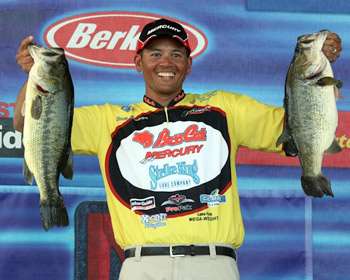
Having towed a boat and launched his bass boat across the country in all manner of lakes, rivers and streams, Elite Series pro James Niggemeyer knows his way around a launch ramp. Through his years as a touring bass fishing professional, he has learned that improperly loading a boat onto its trailer can ruin a trip to the lake.
"I've seen plenty of times where someone loaded their boat and got it crooked on the (trailer) bunks," he says. "This can really create a lot of problems — not only in towing the boat, but also in the wear and tear of your trailer." Niggemeyer points out that getting the boat onto the trailer so that it aligns with the trailer bunks — which provide stability and support while in transport — is one of the biggest keys to proper loading.
"Particularly if someone doesn't have a lot of experience, or if they're trying to load in a hurry or in the wind, getting the boat onto the trailer straight can sometimes be a challenge," he explains. Niggemeyer contends that many times, a crooked boat on its trailer suggests that the driver was backed too far into the water. "A lot of times guys will just back their trailer down until all they can see is the trailer winch," he says. "This is a big problem because at that point, even a little breeze can get the boat crooked and cause all kinds of frustration."
He cautions anglers to submerge their trailer "until you start to see water covering the bunks. This will allow you to ease the boat onto your trailer and up close to the winch without getting on top of it. You don't want to come in with the bow of the boat above the (trailer's) winch." With the trailer too far under water, he explains, you won't be able to take proper advantage of the trailer's design. It's meant to serve as an alignment guide to the bow fastener and winch. Getting the bow of the boat to that point is "one part winch, and one part big motor," according to the Texas pro.
"You want to have enough of the trailer under water so that you can float the majority of the bow as close to the winch as possible," he says. "I typically don't want more than a couple of cranks on the winch. Anything more than that and you're in for a lot of trouble because a 20-foot fiberglass boat is almost impossible to winch more than a few inches."
With approximately half of the trailer submerged, the boat will naturally glide onto the trailer bunks, eliminating the likelihood of overshooting the winch or getting the boat onto the trailer crooked. While his primary boat may be a 20-foot fiberglass rig, James explains that his loading technique is applicable to all fishing vessels and on all manner of ramps. "I've launched on gravel and dirt ramps, on asphalt ramps, and I've even backed down the bank into the water and just dumped the boat off." And in each instance, James explains that when getting the boat back onto his trailer he follows the same procedure — or at least as closely as the terrain will allow. "I do it the same way every time, even when I'm fishing alone," he says.
"Now, if you're fishing by yourself in a small lake in an aluminum boat, you might have to alter that. In either case though, you never want to have the bow of the boat above the winch." Even on ramps with a tremendous incline, James points out that it's possible to load the boat without having to either winch it all the way up the trailer or worry that the bow will end up in the cab of your tow vehicle.
"In those cases, back the trailer in far enough so that your boat can get centered on the bunks," he says. "Once the bow is resting on the trailer, you can ease it forward with the big motor. You just want to get the bow as close to the winch as possible."
(Provided by Z3 Media)




